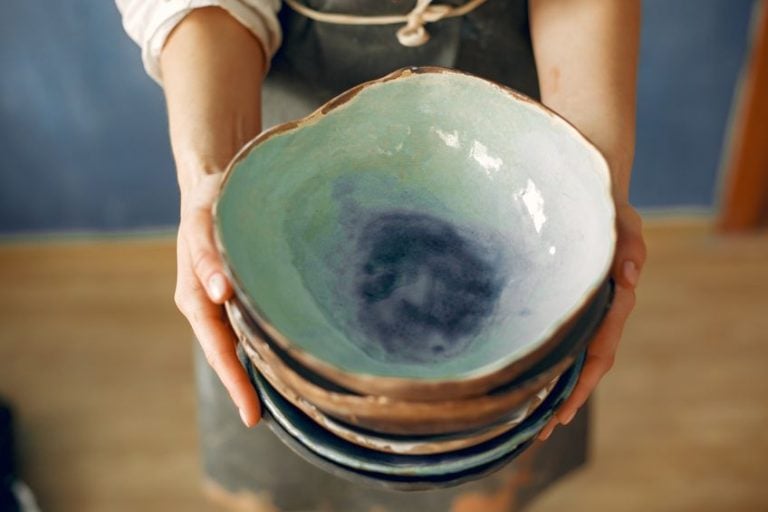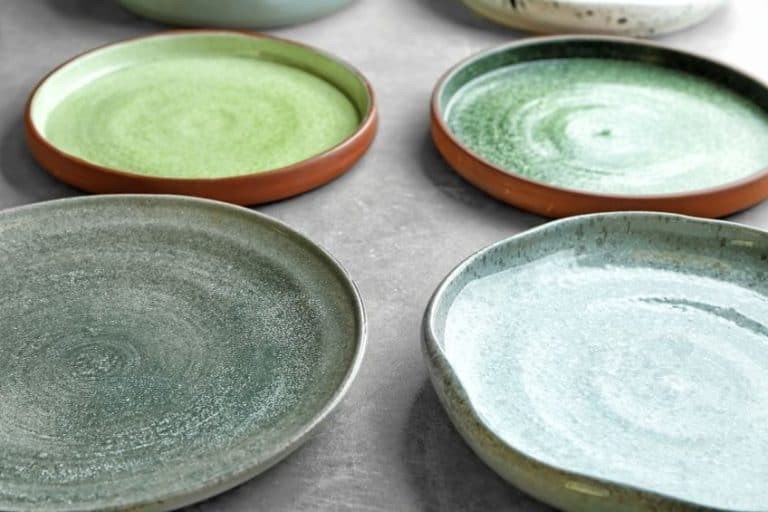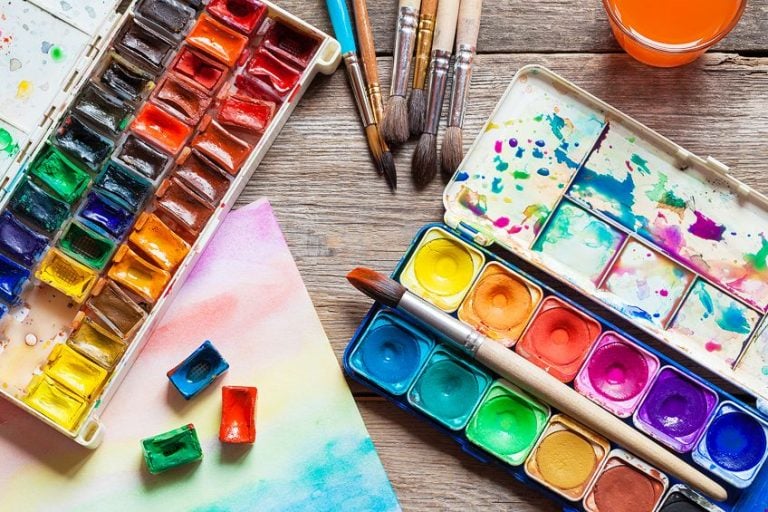Airbrush Paint Guide – Everything Beginners Need to Know
Airbrushing can be a fun and quick way to create art or paint any size and type of surface. However, airbrushing may seem quite challenging for beginners because of all the necessary tools and paints needed. The airbrushes themselves come in many shapes and forms, but that is a whole other discussion. For now, we are going to provide you with information that is focused on an airbrush paint guide. So, read further to discover what airbrush paints you can use, how to use them, and more!
What Is Airbrush Paint?
You can use paint for an airbrush gun to spray many different surfaces, as long as the pain is the proper consistency, which is generally runny like milk. Some of the uses for an airbrush include the following.
- Can be used for priming
- Apply base coats
- Spray stencils
- Spray miniatures
- Glazing
- Varnishing
When deciding on what paint to use in an airbrush, there are many brands and different types of airbrush paint. Some of the types of airbrush paint include acrylics and oil paints among others, each one best used for a specific application. In our airbrush paint guide below, we will be sharing each of these types of airbrush paints, so you get the best possible results for your airbrush art.
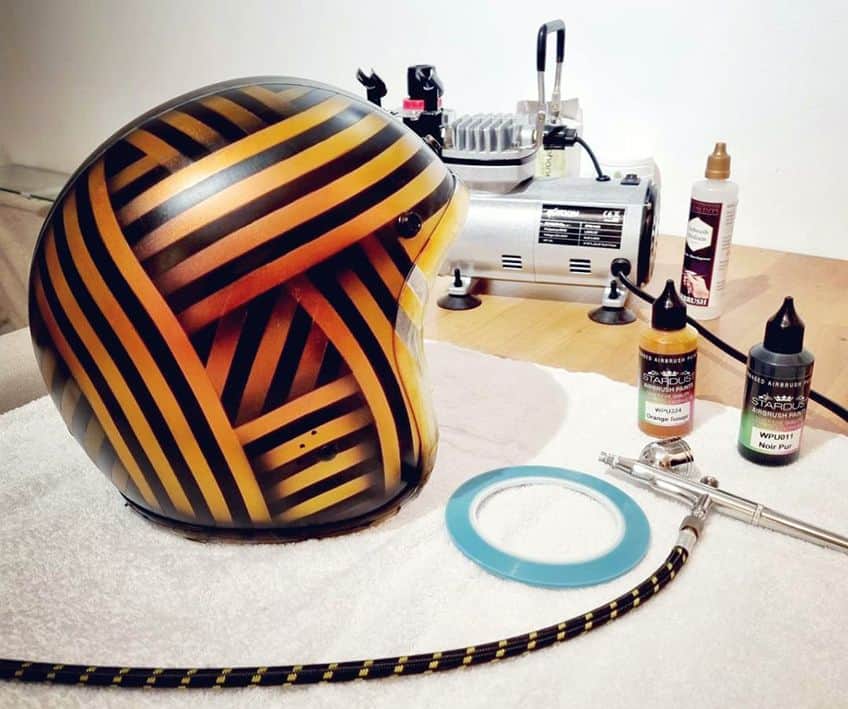
Different Types of Airbrush Paint
You can use paint with an airbrush as long as the paint is thin and can spay an even consistency over a surface. The best paint for an airbrush gun is the commercially available airbrush paint and acrylic paint. The airbrush paints are all ready-to-use and are specially made for airbrush guns. Acrylic paint is the easiest alternative to work with, as it can be quickly thinned by using water.
The airbrush paints are easier to work with if you need to still dilute it. Even if you dilute it too much, the paint will still stick to the surface, unlike other paints that can just slide off. If the airbrush paints need to be diluted, you can also simply add water, or you might need to use an airbrush thinner.
Always remember the milky consistency needed to spray paint, however, the viscosity can change according to the type of paint being used.
When using thicker paints, you should use an airbrush with a more sizable nozzle. For example, a 0.5 mm nozzle can handle heavier paints. You will need to be careful what you use for smaller nozzles, which are best for only thinner paints.
You should always read the instructions that come with the airbrush paint and follow the provided thinning guidelines. The instructions usually also recommend what size of nozzle is best. Below is a brief overview of the different types of airbrush paint.
| Types of Airbrush Paint | Applications | Top Problems | Cleaning |
| Acrylic Paints | Can be applied to most surfaces | Can clog the nozzle | Soap and water |
| Watercolor Paints | Paper or canvas | Not durable | Soap and water |
| Urethane | Heavy-duty work only | Toxic | Solvents like paint thinners |
| Enamel Paints | Can be used on concrete, wood, brick, and metal | Correct thinning and cleaning are required | Paint thinner or mineral spirits |
| Oil Paints | Oil paint can be used on fiberboard, canvas, glass, wood, and aluminum | Correct thinning and cleaning are required | Paint thinner or mineral spirits |
| Dyes and Inks | Ink is great for use on canvases and paper materials | Can flow a little too much | Airbrush cleaner |

Acrylic Paints
These paints are easy to work with and are simple to clean. Acrylic paints are also quite versatile when used for airbrushing. Acrylics can be used to spray almost any surface and can be used in a variety of applications. Acrylics are ideal because they dry fast, can easily be thinned, are non-toxic, and produce even coverage. There is also a variety of colors and various types of acrylic paints available.
You will need to thin the acrylic paint to the proper consistency.
Some acrylic paints are thinned, but for most, you will need to use a suitable thinning agent to prevent clogging up the nozzle. Always clean the airbrush nozzle straight away when you are done spraying with some soapy water. If you allow the acrylic paint to dry, this can become a problem.
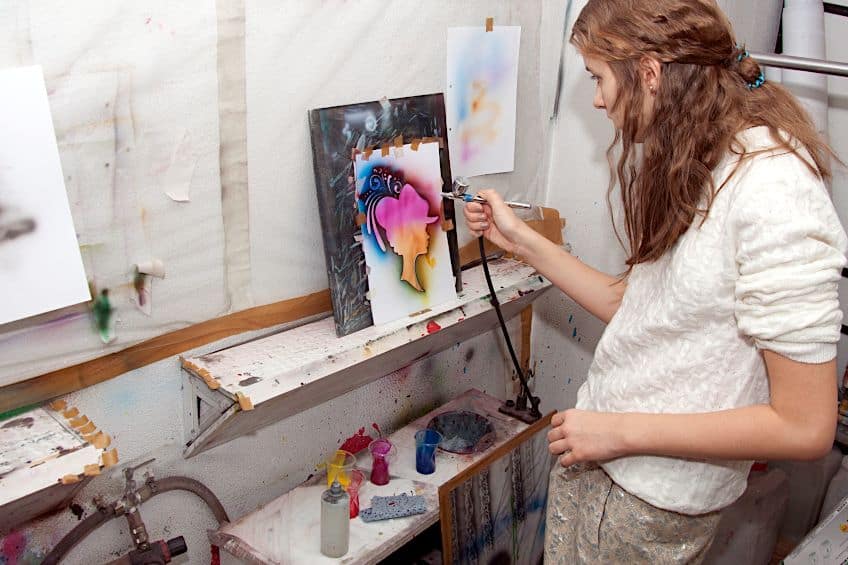
You should use high-quality acrylics or high-flow acrylics when using an airbrush gun. The cheaper acrylics that you might already have at home will clog the nozzle, even if it has been diluted. This has to do with the larger size of the pigments, whereas better-quality acrylics contain finer pigments, making it much easier to dilute and spray.
Watercolor Paints
This type of paint has the perfect consistency and will not clog the spray gun nozzle. If you need to thin the watercolor paint even more, you simply add water. The paints are also easily cleaned with some soapy water. However, even though the watercolors have a great consistency, they are not durable. So, if the paint is left unprotected after application, the paint can be affected. You can apply a fixative or varnish the surface after spraying.
Watercolors come in different forms including block paints, tube paints, and liquified watercolors.
The block paints are difficult to spray paint with, as you will need to work in some water and then produce enough to add to the spray gun. This usually only produces a small amount. Tube watercolors are the most popular for use with an airbrush. Simply mix a little water with the paint to attain the correct consistency.

Liquified watercolor paint is a mixture of pigments and dye and is already thinned and ready to use. You might also consider gouache or tempera paints, which are more opaque and thicker in consistency, so they might need to be thinned. They are perfect if you wish to cover any mistakes.
Urethane
The urethane paints are extremely durable but can be toxic, and are usually only used for more heavy-duty applications, such as working on cars and boats. This type of paint is toxic because it gives off volatile organic compounds (VOCs), which can be harmful if inhaled.
This is why you will also need a respirator if you plan to spray this type of paint.
Enamel Paints
Enamel paints are difficult to work with since it needs to be correctly thinned and you need to use toxic solvents to clean it off the airbrush gun. You will also need to work with a respirator or at least wear a mask to help prevent breathing in the harmful paint particles and solvent fumes. Since it is difficult to properly thin these types of paints, it is not recommended for beginners. The paints do provide a nice finish but are very work-intensive, and if not thinned correctly, they can clog the nozzle and will not provide an even application.
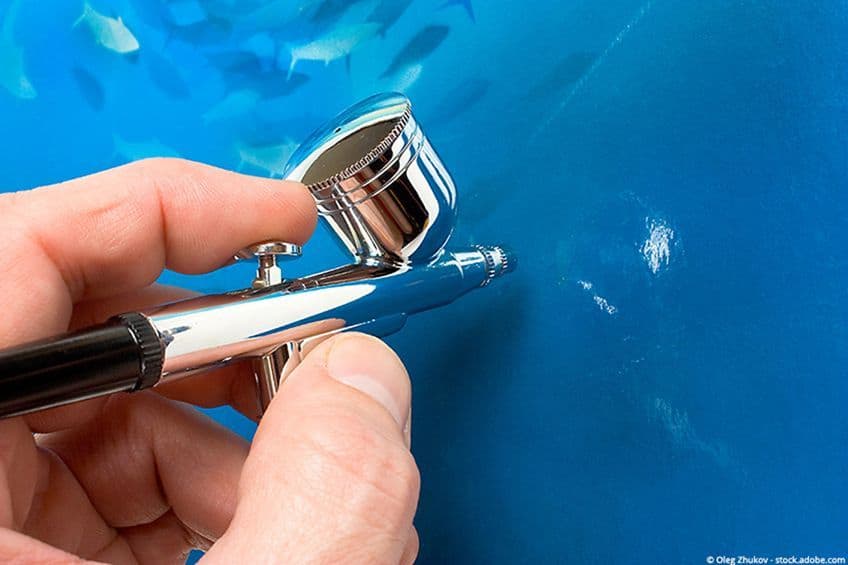
Dyes and Inks
These are great for use with an airbrush gun, as the consistency is ideal, and they require less air pressure when spraying. Many of the dyes and inks are ready to use and provide a variety of vivid colors. Before using the ink, always make sure to shake the bottle. One of the problems with inks is that they also tend to be too runny, so do not thin them. You might need to wait for it to dry before applying another thin layer. You can also use food-grade dyes or inks to spray things like cakes and other edible items.
Another great option for beginners.
Oil Paints
These paints are also a bit challenging to work with, as the paint needs to be correctly thinned. This is usually done by adding solvents like turpentine or mineral spirits. These are also not very nice to work with as they do not smell all that great, and you will need to work in a well-ventilated area.

What Is Important When Choosing Paint for an Airbrush Gun?
What are the main things to look for when choosing paint for an airbrush gun? The most important thing to look out for is consistency, which should be thin like milk. The paint should also have pigments that are finely ground so that it will not clog the airbrush nozzle. The airbrush paints themselves have additives that help with the flow of the paint and are also easy to clean. Sometimes, airbrush paint might still need to be thinned to provide the best spray application. For example, some metallic paints are thicker and can clog the nozzle if not thinned. Ultimately, the paint should be thin, mixed well, with no clumps.
The following is what you need to look for in a good airbrush paint.tp21
Coverage
A good airbrush paint will provide even coverage in one coat. The airbrush paints also usually have good color coverage. However, if you are looking to apply a glaze, all you need to do is add a little water.

Durability
Does the paint peel or crack after application? Some paints have much better durability than others, but most airbrush paints do offer some durability. These types of airbrush paints are generally applied in thin layers, so they are prone to be less durable than thicker paints anyway.
So, you should always handle airbrushed surfaces more carefully, or make sure to apply a protective layer of varnish.
Viscosity
Some airbrush paints are thicker than others, depending on the use of the paint and the particular manufacturer. The thicker paints provide better coverage, while thinner paints can provide a more translucent effect. Also, remember that the paints are used for different purposes, for example, the different paints can be for miniatures, nail artists, wall murals, and more.
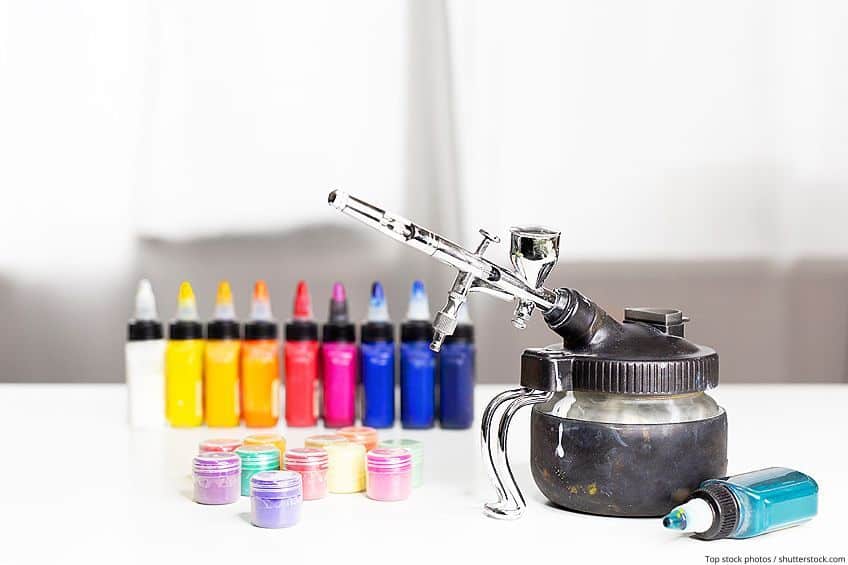
Price
When purchasing airbrush paints, you are getting less than normal when comparing them with normal acrylic paints of the same volume. This is because the paints are thinned, so there might be a slight price difference. Also, the different brands available, such as Vallejo or Game Air, might cost more than another unknown brand.
It is also not a good idea to go for excessively cheap paints, as this could lead to several problems you could have avoided, and which might cost you in the long run.
Variety of Colors
Airbrush paints usually come in a variety of colors, which you can purchase separately or as a set. Some colors that you get for professional artists or hobbies, might be difficult to come by. However, if the paints are not pro-artists, and you are not too worried about brand names, then there is a wide range of colors that are easily available.

How to Use Airbrush Paint
We have learned that the most important thing to consider when using airbrush paint is its consistency. If it is not airbrush paint, the paint you use most likely will need to be thinned before airbrushing it. You do not want to get your airbrush gun nozzle clogged, as this will produce uneven application. So, how to use airbrush paint? Most popular airbrush paints are water-based, so it is quite easy to thin with water. However, depending on the type and quality of the paint, it should not be thinned too much as it will affect the coverage. Good quality airbrush paints will not have this kind of problem.
Other paints are not water-based, and you will need other types of liquids like solvents to thin the paint.
Thinning Paint Using Solvents
Paint thinners or mineral spirits will need to be used for oil-based paints, but should not be too aggressive, as this could damage the airbrush. So, read the labels on a product you aim to use for the airbrush paint, as it will usually inform you of the materials that can be damaged.
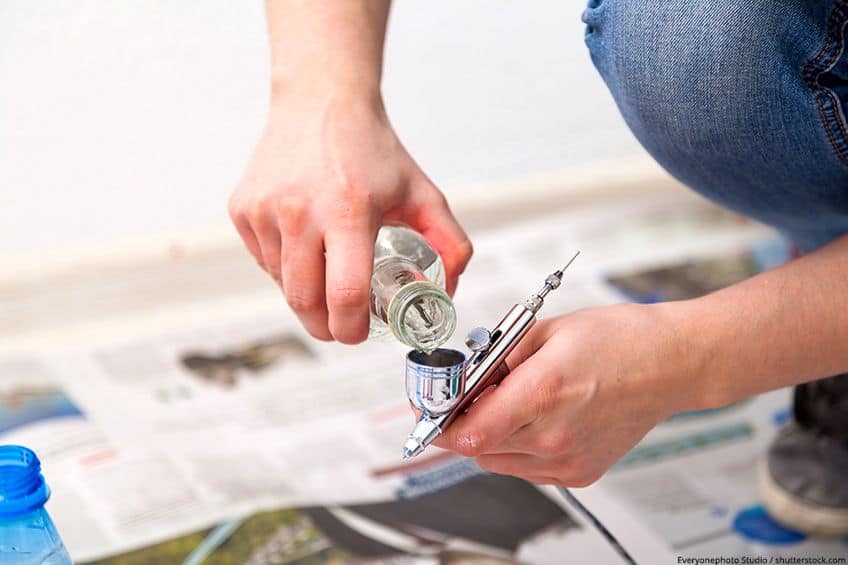
Thinning Water-Based Paints
Acrylic paint is a popular airbrush paint and is great for beginners. The paint is affordable, and it is easy to thin it by simply adding water. The best option, as we have mentioned above, is to use high-quality acrylics as these tend to have no issues when thinning. Also, most households have running “soft water”, which contains very little mineral deposits. This water is perfect for airbrushes, as “hard water” that contains minerals can form mineral deposits on the inside of the airbrush, which can be difficult to clean. You can also try using an airbrush thinner or medium, however, this is more expensive and might also come with certain health risks.
The common ratio for thinning acrylic paint is one drop paint to three drops water, which can be adjusted as needed.
Thinning the Paint Outside of the Airbrush
The most popular method for thinning paint is to do it outside of the airbrush on a palette. After you have mixed the thinner and paint, you can then transfer this to the airbrush cup, using an eyedropper. You can check the viscosity of the paint after being mixed, by simply pulling some paint up the side of the palette or dish you are using. If the paint runs as it should, it is ready to be transferred.

Depending on the application, you might want to make it thicker or thinner. Thinning the paint outside the airbrush can prevent dust or particles from settling in the paint, which could eventually clog the nozzle. This method is best if you plan to spray paint a larger surface area, as premixing can take more time and it can waste paint. If it is just a touch-up, rather thin inside the airbrush cup.
Thinning the Paint Inside the Airbrush
For this method, first, add an amount of thinner to the paintbrush cup, then add the paint. Again, the ratio depends on the application. Mix the two ingredients using a toothpick or the back end of a paintbrush. Depending on the type of airbrush, you might have to do this a little differently. For example, an airbrush with a closed nose cone. Place the thinner and paint into the paint cup, and close the front section of the nose cone, which blocks the airflow. Push the trigger down slowly, and the back pressure will send air bubbles into the cup, which should mix the two liquids.
Repeat the process at least one more time.
How to Clean an Airbrush Gun
Cleaning should be quite easy if you handle it as soon as you are finished using the airbrush. Do not leave the airbrush without cleaning, as this could cause the paints to dry, and it will be difficult to properly clean it again. You have proper airbrush cleaners you can use for all types of paint, or you can use different cleaning methods.

When using water-soluble paints, a bit of soapy water will do the trick. For other cleaners for non-water-soluble paints, cleaners like paint thinners or mineral spirits are best. Whatever paint or cleaner you use; it is best to clean the airbrush with an airbrush cleaner every so often. These methods are used to flush the airbrush, and when done, you should always end with flushing with water. To thoroughly clean an airbrush, you might have to disassemble it to soak and clean the different parts.
If you do forget to clean the airbrush after using acrylic paint, you can try the following. Try soaking the airbrush in a brush restorer liquid, which can help to unclog the airbrush. Wash the airbrush out before using it again. You can also consider using an ultrasonic cleaner that uses high-frequency waves to clean. However, never use this method on the airbrush needle, which you should set apart. The best thing to do when using an airbrush is to get into the habit of cleaning straight after you are done using the airbrush.
Consider the below basic steps for cleaning your airbrush.
- Remove the paint cup and empty it, and then perform a paint flush with the airbrush cleaner.
- Remove the needle and wipe clean with some airbrush cleaner, reattach, and then flush normally with water.
- Remove and clean the nozzle, nozzle cap, and needle cap, using the airbrush cleaner. You can use a small cleaning brush for a more effective cleaning.
- Make sure to also clean the paint passage with airbrush cleaner.
- Finally, wipe and clean the outside of the airbrush.
Safety Guidelines When Airbrushing
When airbrushing there are always safety precautions you need to take, especially if you are using any kind of solvent or potential toxic materials. If you are using oil-based, enamel paints, or solvents, you should invest in a good respirator. If you are using water-based paints, you should at least be wearing a mask to protect yourself from the paint particles flying around in the air. Some other safety guidelines when airbrushing are as follows.
- Consider wearing gloves and eye protection, as the overspray can get everywhere.
- If you use an airbrush often, consider getting a proper spray booth that helps with ventilation.
- Always work in a well-ventilated area and have a few fans blowing, even if you have a spray booth.

There are many things to consider if you want to get into airbrushing. You will need to purchase a proper airbrush gun, and also gain an understanding of how to use airbrush paint. We hope our basic airbrush paint guide has given you the confidence to go out and try airbrushing, as it provides effortless coverage and is a faster way to complete your paint projects!
Frequently Asked Questions
What Is Airbrush Paint?
Airbrush paint is used in an airbrush to create a smooth and even coverage on a variety of surfaces. To achieve this, the paint has to be quite thin so that it can easily be sprayed and does not clog the airbrush nozzle. So, the most important characteristic of airbrush paint is its consistency.
What Paint to Use in an Airbrush?
There are a variety of paints that you can use in an airbrush, however, some require thinning before you can use them. The most common is ready-to-use airbrush paint, but you can also use acrylic paint, oil paints, enamel paint, watercolor paints, and inks or dyes. Other less common paints that can be used in an airbrush include fabric paints, latex paints, automotive paints, and even food paints.
Is There a Difference Between an Airbrush Thinner and a Thinner Medium?
An airbrush thinner is usually an alcohol-type ingredient that helps to reduce the paint viscosity. The thinner medium is usually a water and acrylic mix that helps dilute the color but maintains the consistency of the paint.
In 2005, Charlene completed her Wellness Diplomas in Therapeutic Aromatherapy and Reflexology from the International School of Reflexology and Meridian Therapy. She worked for a company offering corporate wellness programs for a couple of years, before opening up her own therapy practice. It was in 2015 that a friend, who was a digital marketer, asked her to join her company as a content creator, and this is where she found her excitement for writing.
Since joining the content writing world, she has gained a lot of experience over the years writing on a diverse selection of topics, from beauty, health, wellness, travel, and more. Due to various circumstances, she had to close her therapy practice and is now a full-time freelance writer. Being a creative person, she could not pass up the opportunity to contribute to the Art in Context team, where is was in her element, writing about a variety of art and craft topics. Contributing articles for over three years now, her knowledge in this area has grown, and she has gotten to explore her creativity and improve her research and writing skills.
Charlene Lewis has been working for artincontext.org since the relaunch in 2020. She is an experienced writer and mainly focuses on the topics of color theory, painting and drawing.
Learn more about Charlene Lewis and the Art in Context Team.




